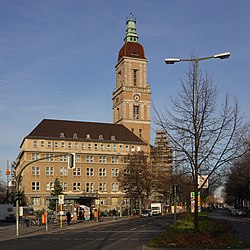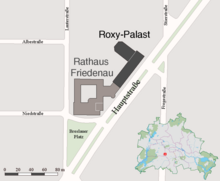Friedenau town hall
| Friedenau town hall | |
|---|---|
 Friedenau town hall |
|
| Data | |
| place | Berlin-Friedenau |
| architect | Hans Altmann |
| Architectural style | Historicism , neo-baroque , neoclassicism |
| Construction year | 1913-1916 |
| height | 71 m |
| Coordinates | 52 ° 28 '21 " N , 13 ° 20' 9" E |
The Town Hall Friedenau is an administrative building , which in the seventh Berlin administrative district Tempelhof-Schöneberg belonging district Friedenau is.
location


The town hall is located at the transition from Rheinstrasse to Hauptstrasse at the corner of Niedstrasse and Lauterstrasse. Originally it was to be built on the nearby Wilmersdorfer Platz (today: Renée-Sintenis-Platz). After long discussions, however, the site at what was then Lauterplatz was awarded the contract (named after the Lauter , a left tributary of the Rhine ). Lauterplatz kept its name until 1961 when it was renamed Breslauer Platz .
history
The foundation stone for the building designed by the architect Hans Altmann was laid on October 13, 1913; it was completed in the war year 1916 and officially opened in 1917. The historicist style mainly takes up elements from the neo-baroque . The town hall was built for the administrative tasks of the then independent country house colony Friedenau. The construction became necessary because the population of Friedenau increased considerably due to the building regulations issued in 1892. The resulting municipal tasks could now be carried out directly by the new town hall.
When planning the town hall, the then new Friedenau fire station was planned in Lauterstraße . The access roads for the fire engines are still there today. The facade decorations on their arches consist of four half-reliefs that show motifs from everyday fire services. The fire station is no longer in operation today.
With the formation of the unified community of Greater Berlin in 1920, Friedenau lost its communal independence and from then on belonged to the Schöneberg district . The town hall now served administrative purposes within the new district office.
After the Second World War , from April 29 to June 30, 1945, Friedenau was under Soviet occupation and was administered from here as an independent 21st Berlin district by the communist Willy Pölchen as district mayor. After the Berlin districts were divided up among the victorious Allied powers , Friedenau again belonged to the Schöneberg district, which was part of the American sector from 1945 to 1990 and was merged with the Tempelhof district to form the new Tempelhof-Schöneberg district in 2001 .
The building, which was heavily damaged in World War II, was rebuilt between 1950 and 1956. In particular, the facades of the front building facing Breslauer Platz were greatly simplified. The town hall originally had a low basement with semicircular windows, and above them on the mezzanine floor, ribbon-like windows interrupted by pilasters . The main floors rose above a sturdy cornice and were framed by four-story round cores with brick hoods on the main front facing Breslauer Platz . The portal was framed by a Doric column portico that carried an arbor that was in front of the three-axis bay window in front of the meeting room. The front of the square was raised between the round core by a three-axis transverse gable, which was crowned by a round arch with the coat of arms of Friedenau.
During the reconstruction, the round bay window, column portal, central bay window and transverse gable were dispensed with; a uniform, neoclassical facade with double windows was built in place of the once very lively and three-dimensional front of the square. The facades of the side wings facing Hauptstrasse and Lauterstrasse as well as the 71-meter-high tower, which forms an urban landmark that can be seen from afar, have been preserved in the original design .
As of the district reform in 2001, the current municipal structure of the Tempelhof-Schöneberg district meant that Senate departments were active in the Friedenau town hall.
Since February 2016, the Friedenau town hall has accommodated up to 319 refugee women and children from around 45 nations. The last resident youth welfare office moved to Rathausstrasse in the Mariendorf district .
A weekly market has been held regularly (Wednesdays, Thursdays and Saturdays) on the triangular Breslauer Platz in front of the town hall since 1881 . This makes it the oldest weekly market in Berlin. When the town hall was founded, the square was called a grove , sometimes also a school square , because of its stock of trees .

